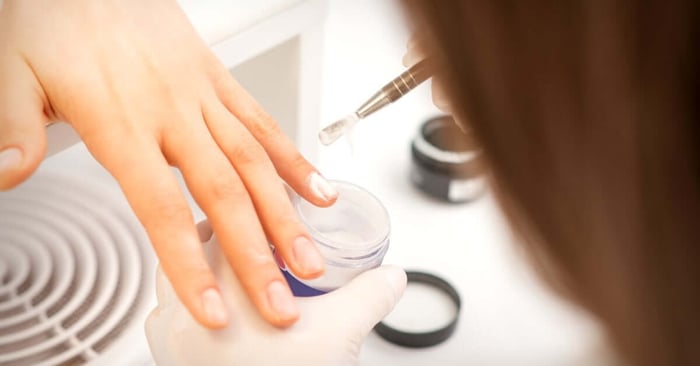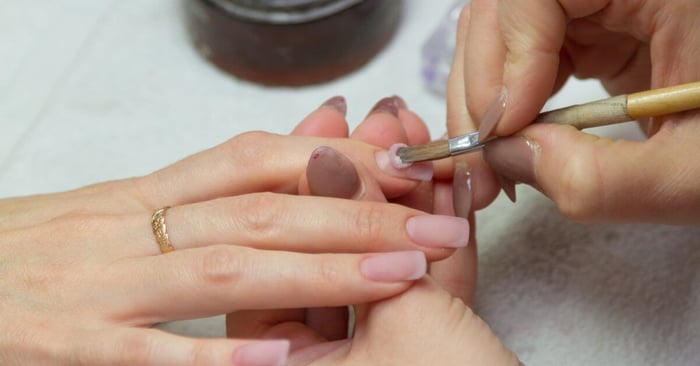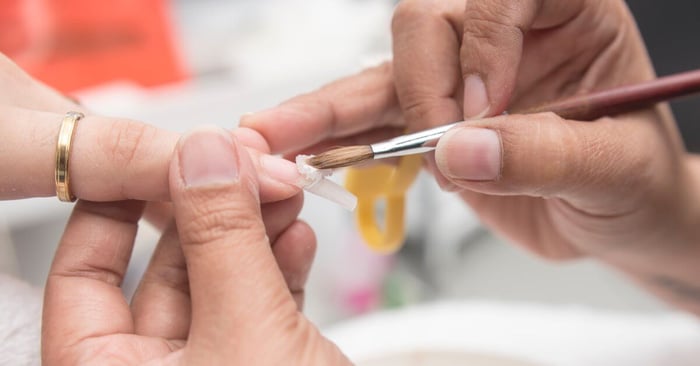When sculpting acrylic nails, the ratio of acrylic powder to liquid monomer is really important. This small detail can mean the difference between a durable set of nails and one with a slew of problems. Knowing why the right ratio of acrylic powder to monomer matters can affect the quality of your work and the satisfaction of clients.
What Is the Acrylic Powder-to-Monomer Ratio?
The foundation of every set of acrylic enhancements is the correct mixture of powder and monomer. If the ratio is off, you run the risk of lifting, cracking, air pockets, and other problems. The acrylic powder-to-monomer ratio refers to the balance of the two ingredients needed to create a workable consistency for sculpting. When the liquid monomer reacts with the acrylic powder, a chemical process forms the pliable bead, which nail technicians use to build and sculpt nails. Typically, the ideal ratio is two parts liquid to one part powder. Keep in mind that these numbers can vary depending on the product and environmental factors.
Why the Perfect Ratio Matters
The ratio plays several roles in determining the strength, durability, and appearance of acrylic nails. When the balance is correct, you get a bead that is smooth, pliable, and easy to control. The nails cure at the expected rate, creating great results for clients. Conversely, an incorrect ratio can result in acrylic that is brittle, prone to lifting, or unevenly textured. As the nail professional, you may struggle to get the nails right and create the final set, and the clients will likely have problems with longevity of wear.

Too Much Monomer
Using too much monomer in your mix can lead to several problems. If the bead is overly wet, it’s challenging to work with and control. This can cause acrylic to flood the cuticle area, increasing the likelihood of lifting and potentially causing allergic reactions over time. Excess monomer also slows curing, which can weaken the acrylic structure and shorten the lifespan of the nail.
Too Much Powder
Using too much acrylic powder in your mixture can create a bead that is too dry and lacks the necessary flexibility to sculpt smoothly. This often results in lumps and bumps on the nail surface. Dry acrylic is also more prone to becoming brittle once cured, which increases the likelihood of cracking or breaking. Getting the ratio right prevents these issues and ensures the seamless application of the bead. When a technician mixes the correct liquid-to-powder ratio, they can sculpt a smooth, durable nail that won’t develop cracks.
Environmental Factors
External factors, such as temperature and humidity, play a role in how acrylic beads form and cure. High humidity can slow the curing process, making the bead runny or difficult to control. Cold or dry conditions may cause it to set too quickly, leaving little time for shaping.
If you work at a coastal salon, you might notice that your usual acrylic mix is wetter and takes longer to cure during rainy weather. To compensate, you might adjust the ratio or choose a faster-setting monomer to maintain the consistency. For example, a nail artist who adapts their mix on a humid day delivers a smooth, flawless set for the client. This kind of environmental awareness and flexibility showcases your professionalism and leads to great results.
Mastering Liquid Control During Application
Finding the ideal ratio lies in liquid control during application. By dipping your brush into the liquid monomer and pressing it into the acrylic powder with a steady hand, you can create a bead that has the perfect consistency. Practicing the technique may involve trial and error, particularly when switching between brands or formulations. Developing this skill will help you achieve the right balance every time.
Why Some Products Are Easier To Work With Than Others
Not all acrylic systems are created the same; some are intentionally more forgiving when it comes to liquid-to-powder ratio inconsistencies. This flexibility can be especially valuable for new technicians still mastering their mix control. High-quality acrylic powders and liquid monomer systems, typically developed with professional-grade formulations, come with clear ratio guidelines so you get consistent results.
If you are a newly licensed nail technician who struggles with maintaining the same ratio during back-to-back appointments, don’t fret! You can still achieve great results by switching to a premium acrylic system that tolerates slight deviations. Investing in the right materials boosts your confidence and improves efficiency and client satisfaction.
The Importance of Practice and Training
Even seasoned nail technicians understand the value of practice when mastering the acrylic powder-to-monomer ratio. Perfecting this skill may involve formal training, workshops, or tutorials that teach the appropriate techniques. Many brands offer education and certification programs, making it easy for nail professionals to refine their craft and stay up to date on industry trends. With consistent practice, achieving the correct ratio eventually becomes second nature.

How To Avoid Common Mistakes
Some of the most common mistakes in acrylic application include using a brush that is too wet, working too slowly, or not accounting for environmental changes that affect curing times. You can avoid these pitfalls by staying mindful during application and regularly assessing the quality of your work. Spotting the signs of an incorrect ratio before application allows for quick adjustments.
Enhancing Client Satisfaction With the Right Ratio
Clients may not understand the science behind acrylic nails, but they can certainly tell when something is wrong. They expect nails that feel comfortable and last for weeks. Maintaining the correct ratio of acrylic powder to liquid monomer for acrylic nails allows you to deliver on these expectations. The dividends of this attention to detail include satisfied customers, repeat business, and a professional reputation that stands out in the beauty industry.
Determining the correct ratio of acrylic powder to monomer takes time, understanding, and practice, but the effort is worth it! By achieving consistency in your application, you’ll produce durable nails that clients will love. Precision and attention to detail in this step reflect your professionalism.


